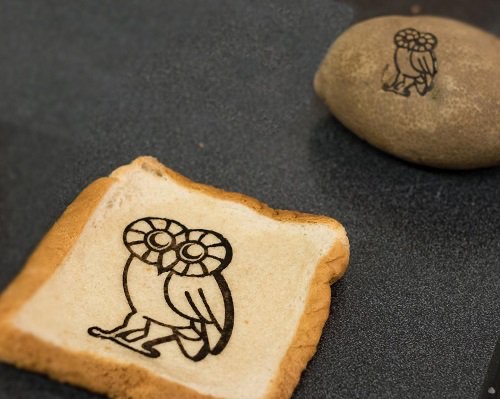http://www.asyura2.com/16/health18/msg/845.html
| Tweet |

Graphene on food may help determine illness in food or in your body. Source: Rice University
(コロナワクチンに入れられてる酸化グラフェンは猛毒です。ポジティブな部分だけ目をつけて食品にして食べさせるなんて恐ろしい。しかし、あらゆる分野で我々の生活に使われつつある。これだけではない。byこーるてん)
Smalley-Curl研究所、The NanoCarbon Center、ライス大学の研究者グループは、食品を含むあらゆる表面にグラフェンパターンを書き込む方法を開発した。
この新たなブレークスルーは、農場から食卓までの食品の経過を追跡したり、胃の不快感を引き起こす有害な生物を検出したりすることができる、食用電子機器の新たな領域の基礎となる可能性があります。
グラフェンは、単層の炭素原子が蜂の巣状に配列された不思議な素材で、鉄よりも強く、髪の毛よりも薄い一方で、銅よりも高い導電性を持っています。レーザー誘起グラフェン(LIG)と呼ばれるプロセスは、架橋された微小なグラフェンフレークで作られた形で、スーパーキャパシタ、RFID(Radio Frequency Identification)アンテナ、生体センサーなどに使用するためのパターンを埋め込んだり、焼いたりするものである。
研究者たちは、適度な量の炭素を含むあらゆる物質をグラフェンに変えることができるかどうかを調査し、最終的には、LIGを食品や段ボールなどの日常的な炭素ベースの素材に焼き付けることにした。
研究方法
研究チームは、単一のレーザーパルスを用いて、対象物質の表面層をアモルファスカーボンと呼ばれる無秩序な原子の集合体に変えた。その後、デフォーカスしたビームで複数回レーザーを照射し、すすをグラフェンに変換した。
今回の実験では、他のLIGプロセスでは行われていない、制御された雰囲気のボックスを必要としない室温でのグラフェン変換が行われました。その結果、紙、厚紙、布、ジャガイモ、ココナッツ、トーストしたパンなどの食品に焼き付けることができました。
研究者たちは、最終的にはLIGから作られたRFIDアンテナで食品にタグを付けることができると考えている。これにより、食品がどこから来たのか、どのくらいの期間保存されていたのか、どのようにして食卓に運ばれたのかを追跡することができる。また、サラダや肉などの食品に潜んでいる大腸菌などの有害な生物を発見するのにも使えるかもしれない。
原文
Graphene on Your Toast Could Tell Why Your Stomach is Upset
A group of researchers from Smalley-Curl Institute, The NanoCarbon Center and Rice University have developed a way to write graphene patterns onto any surface including food.
The new breakthrough could be the foundation for a new realm of edible electronics that could trace the progression of foods from farm to table as well as detect harmful organisms that cause gastric distress.
Graphene is considered a wonder material as it is composed of a single layer of carbon atoms arranged in a honeycomb pattern, is stronger than steel and thinner than a human hair while at the same time being more conductive than copper. A process called laser-induced grapheme (LIG) is a form made out of tiny cross-linked graphene flakes to embed or burn patterns for use as supercapacitors, radio frequency identification (RFID) antennas or biological sensors.
Researchers investigated whether any substance with a reasonable amount of carbon can be turned into graphene with the end result being to burn LIG into food, cardboard and other everyday, carbon-based materials.
How They Did It
The team used a single laser pulse to convert the surface layer of the target substance into a disorganized jumble of atoms called amorphous carbon, otherwise known as black soot. They then conducted multiple laser passes with a defocused beam to convert the soot into graphene.
The graphene conversions in the experiments were done at room temperature without the need for a controlled atmosphere box, something that has not been done in other LIG processes. The result was LIG that could be burned into paper, cardboard, cloth, potatoes, coconuts, toasted bread and other foods.
Researchers believe food items could eventually be tagged with RFID antennas made from LIG that could help track where a food originated, how long it has been stored or how it got to a dining table. It could also be used to uncover E. coli or other harmful organisms lurking in salads, meats and other foods.
|
|
▲上へ ★阿修羅♪ > 不安と不健康18掲示板 次へ 前へ
|
|
最新投稿・コメント全文リスト コメント投稿はメルマガで即時配信 スレ建て依頼スレ
▲上へ ★阿修羅♪ > 不安と不健康18掲示板 次へ 前へ
|
|
 スパムメールの中から見つけ出すためにメールのタイトルには必ず「阿修羅さんへ」と記述してください。
スパムメールの中から見つけ出すためにメールのタイトルには必ず「阿修羅さんへ」と記述してください。すべてのページの引用、転載、リンクを許可します。確認メールは不要です。引用元リンクを表示してください。